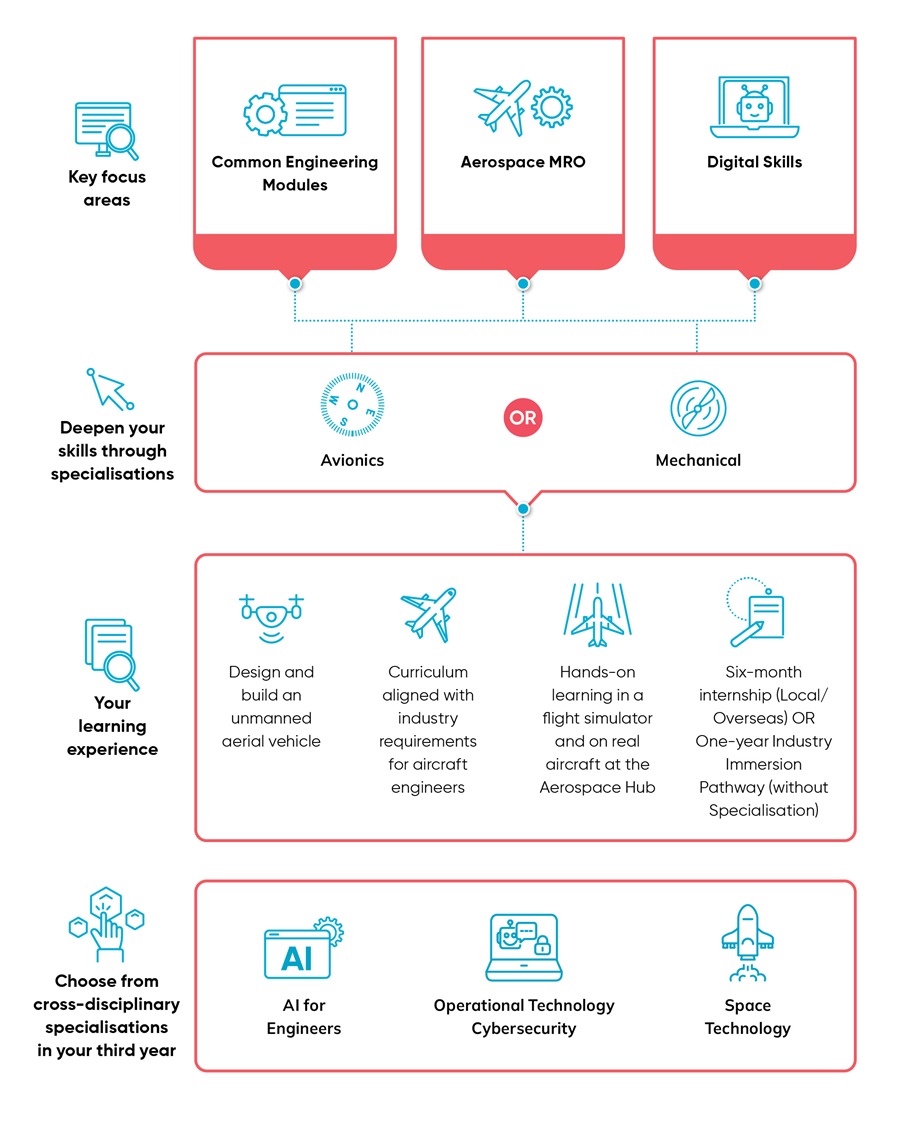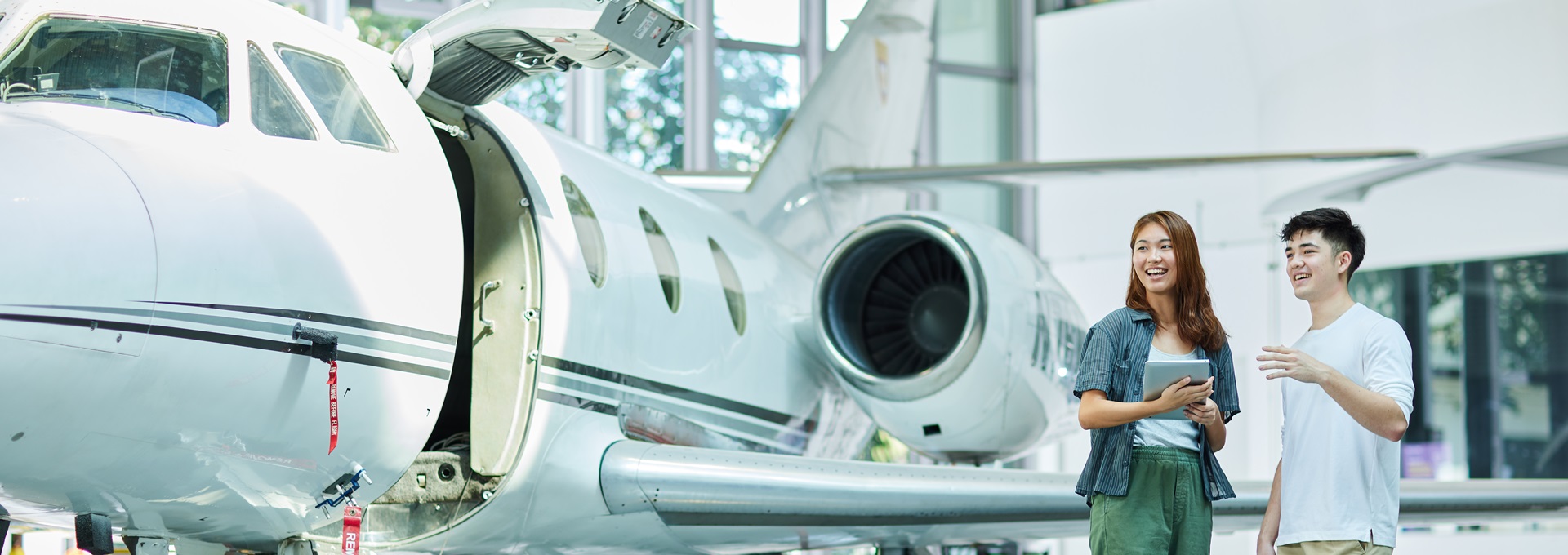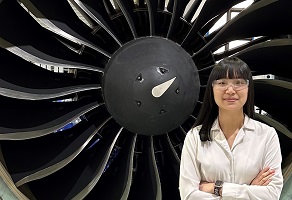Why AEG?
- Gain sought-after digital skills in additive manufacturing, data analytics, artificial intelligence, machine learning, robotics and drones
- Choose to focus on either Avionics and Mechanical in Year 2 and one of our new Cross-Disciplinary Specialisations in Year 3: AI for Engineers, Operational Technology Cybersecurity or Space Technology
- Opportunities to design and build your own aerial vehicle
- Build a strong engineering foundation with green aviation concepts integrated into curriculum
About AEG
Growing up, were you fascinated with how a heavy machine can fly? Do you ever imagine yourself working on the next generation of aircraft? Then come on board the Diploma in Aerospace Engineering (AEG).
As global travel resumes, the demand for aerospace professionals in the industry is set to soar. With this broad-based diploma, you will gain a strong engineering foundation and discover how you can play a role in this fast-growing sector!
Gain insights into the aerospace industry through
modules such as Aerial System Design & Integration,
Aircraft Electrical & Instrumentation Systems, as well
as Aircraft Data Communications & Networking.
As more companies leverage the power of big data
to monitor aircraft health and predict maintenance
schedules, you will be equipped with next-gen skills
such as data analytics, artificial intelligence and
machine learning.
In addition, with green aviation concepts integrated
into the AEG curriculum, you can contribute
significantly to environmental sustainability efforts
within the aerospace sector!
In your second year, you can specialise in one of two areas:
- Avionics
Study the principles of flight and explore sophisticated
aircraft systems, including navigation, surveillance,
data communication, and networking systems.
- Mechanical Learn about engineering system design, aircraft structures and materials, advanced thermofluids, and aircraft maintenance practices.
Our strong links with the industry will provide you with
real-world learning experiences. With some modules
co-developed and co-delivered by our industry partners,
you will gain valuable insights into the trends that are
shaping the aerospace sector.
You will also get opportunities to apply your skills on
projects to solve real-world problems. For example, you
will even get to design and build an unmanned aerial
vehicle!
In your final year, you’ll have the option to either embark
on a six-month local or overseas internship with
companies like Collins Aerospace, Pratt & Whitney, ST
Engineering, and Thales Solutions Asia, or choose the
Industry Immersion Pathway for a year of hands-on
experience. Both options provide real-world exposure,
opportunities to build professional networks, and a
strong head start in your career.
Students who are interested to get their Private Pilot
Licence (PPL) can choose to participate in the Singapore
Youth Flying Club PPL Course as their internship.
To get you future-ready for the dynamic engineering landscape, SOE’s brand-new specialisations will give you a distinct edge.
• Al for Engineers
Develop deep, domain-specific Al expertise by gaining skills in machine learning, neural networks and deep learning.
• Operational Technology Cybersecurity
Acquire cybersecurity competencies to keep industrial operations and critical infrastructure like transport and healthcare secure.
• Space Technology
Gain frontier skills in space tech! Learn about satellite design and systems engineering to meet the increasing demand across aerospace and smart infrastructure sectors.
Overview of Your AEG Journey

Further Studies
As an AEG graduate, you will be able to pursue an aerospace-related degree at Singapore Institute of Technology and Singapore University of Social Sciences, or overseas universities in Australia, New Zealand, USA and the UK.
Or you can choose to pursue related engineering degrees with advanced standing at prestigious local universities like National University of Singapore, Nanyang Technological University, and Singapore University of Technology and Design.
Careers
With Singapore as a leading aerospace MRO provider
in Asia, demand for trained professionals is high. AEG
is recognised by established aerospace organisations,
giving you an edge in exploring careers such as:
- Planning Executive
- Planning Supervisor
- Senior Technician (Engine/Engine Component Repair & Overhaul)
- Senior Technician (Avionics/Mechanical)
- Quality Engineer
- Technical Service Engineer
- Workshop Engineer
Additionally, AEG prepares you for Civil Aviation Authority of Singapore (CAAS) Airworthiness Requirements (SAR 66) exams, giving you a head start towards becoming a licensed Aircraft Maintenance Engineer. You can also pursue skills-deepening programmes or the SkillsFuture Work-Study Post-Diploma Programme after graduation.
Entry Requirements
AGGREGATE TYPE ELR2B2-C
To be eligible for consideration, candidates must have the following GCE ‘O’ Level examination (or equivalent) results.
| Subject | 'O' Level Grade |
|---|---|
| English Language | 1-7 |
| Additional Mathematics/Mathematics | 1-6 |
| Any one of the following subjects: Biology Biotechnology Chemistry Computing/Computer Studies Design & Technology Electronics/Fundamentals of Electronics Physics Science (Chemistry , Biology) Science (Physics, Biology) Science (Physics, Chemistry) | 1-6 |
Applicants must also fulfil the aggregate computation requirements for the ELR2B2-C Aggregate Type ( English Language, 2 relevant subjects and 2 other best subjects) listed at www.np.edu.sg/docs/ELR2B2.pdf.
For students with other qualifications, please refer to the NP website for the entry requirements and admissions exercise period.
Candidates with colour vision deficiency, severe vision deficiency, profound hearing deficiency, uncontrolled epilepsy and/or severe physical impairments may encounter difficulties meeting the course requirements and expectations.
What You Will Learn
Avionics Option
Mechanical Engineering Fundamentals
This module introduces students to the study of external forces in two dimensions and their effect on particles and rigid bodies that are at rest and at simple linear motion. Students learn the knowledge and skills to analyze the forces acting on the bodies by drawing free-body diagrams and applying the conditions of equilibrium. This module also aims to equip students with the skills to analyze problems of rigid bodies in two dimensions linear motion. Topics include forces and resultants, moments and couples, equilibrium, plane friction, kinematics and kinetics of linear motion.
Electrical Engineering Fundamentals
This module provides a foundation in electricity covering basic concepts of electrical circuits and the methods used to analyse them. The module emphasises the understanding of the basic electrical circuit laws (Ohm’s Law, Kirchhoff’s Voltage and Current Laws) and network theorems, and their application to electrical network analysis. Topics covered include fundamentals of electricity, network theorems, capacitance, electromagnetic induction and inductance, AC waveform and transformer fundamentals.
Engineering Mathematics 1
This module is designed to provide students with the fundamental skills in mathematics required to solve basic engineering problems. Topics are introduced in an order that is intended to keep abreast of the application requirements in engineering modules. The emphasis in each topic is on simple applications and problem solving. Topics include algebra, trigonometry, logarithms, plane analytic geometry, matrices and complex numbers. Throughout the module, there is appropriate use of a Computer Algebra System.
Programming
This practice-oriented module equips students with basic knowledge and skills in computer programming using a suitable high-level language. The main topics include basic computer programming concepts and fundamental programming constructs such as sequences, selection and repetition.
Career & Engineering Professional Preparation
This module aims to give students a head-start in their professional careers as they transition into polytechnic engineering education. The module will equip students with knowledge and skills that can help them chart, navigate and advance in their individual education and career pathways. Students will develop fundamental AI literacy as a core competency for modern engineering practice. Students will be guided in adopting a design thinking approach towards making their education and career plans. They will be exposed to career-centric self-assessment tools and online resources. As part of our efforts to help students benefit from the ubiquity of a professional online presence, students will also establish their online professional brand by showcasing their marketable knowledge, skills and competencies. This includes learning to leverage generative AI tools for portfolio enhancement and professional content creation.
To kickstart our students' personal and professional development, the module will also impart various knowledge and skills, such as, cultural intelligence, financial literacy, digital literacy, industry networking and safety. Students will explore how AI applications can enhance these professional competencies within engineering contexts. The topic on safety will be taught according to the Competency Unit "Develop a Risk Management Implementation Plan" from the Singapore Workforce Skills Qualifications (WSQ) National Competency Standard. To augment this qualification, students will participate in industry engagements and service projects to glean the importance of safety in the engineering profession and societal context.
Innovation Made Possible (CCS Module) ^
This module aims to help students discover and hone their innate ability to think creatively and come up with innovations to tackle problems close to their hearts. Underpinned by the Design Thinking framework, students will be sensitised to the process of user-centric problem solving. They will be introduced to concepts such as empathy, problem-definition, ideation, prototyping and testing through a practical approach featuring engaging out-of-classroom activities, just-in-time master-classes and a hands-on, “learning by doing” delivery format. Ultimately, the module will help students recognise that innovation is attainable and fun and develop creative confidence to explore new ideas in their studies and beyond.
English Language Express^*
^* For selected students only
^Critical Core modules account for 13 credit units of the diploma curriculum. They include modules in communication, innovation and world issues, as well as an interdisciplinary project. By bringing students from diverse diplomas together, the interdisciplinary project fosters collaboration to explore and propose solutions for real-world problems. NP aims to develop students to be agile and self-directed learners, ready for the future workplace.
Engineering Mathematics 2
This module is designed to provide students with the fundamental skills in mathematics required to solve basic engineering problems. Topics are introduced in an order that is intended to keep abreast of the application requirements in engineering modules. The emphasis in each topic is on simple applications and problem solving. Throughout the module, there is appropriate use of a Computer Algebra System. Topics include trigonometry, differentiation and simple integration with applications.
Analogue Electronics
The aim of this module is to lay the foundations in analogue electronics. At the end of this module, students will acquire content knowledge and understanding on the basic concepts of analogue electronics and some applications.
Key topics covered in this module include operating characteristics, working principles and applications of discrete electronic devices such as various types of diodes, MOSFETs and BJTs. Practical circuits will be used to enhance and strengthen the learners’ knowledge so that they will acquire the relevant competencies to move on to more specialized modules.
Digital Fundamentals
This module introduces the basic concepts of digital systems. It covers the basics of combinational and sequential logic circuits. Flip-flops and their application in counters and registers will also be discussed. This basic knowledge is essential for students to be able to understand, analyse, and design basic digital circuit system.
Fundamental Electronic & Electrical Skills
This module aims to integrate the knowledge learnt in the semester and understand the relevance and application of the modules learnt. Students will work in teams and undertake the projects/case studies underpinned by the design thinking and electronics prototyping using a microcontroller. On completion of the module, students will be able to apply the skills and develop confidence in tackling projects at the higher levels.
Confident Communication: Find Your Voice (VOICE) (CCS Module) ^
This module is designed to empower students to become thoughtful and confident
communicators, while discovering their personal voice in self-expression. It equips students with the skills to communicate with impact in a variety of settings, by tailoring their message to suit audience, purpose and context. Students will learn how to utilize storytelling structures and techniques, persuasive strategies and effective visuals to connect meaningfully with their audience. The module also features a personalized growth plan that enables students to customize their learning experience according to their individual needs and aspirations. Peer learning and coaching circles provide students the platform to practise their critical reasoning and presentation skills in a safe environment. Ultimately, the module encourages students to reflect on their communication habits and develop practical strategies to enhance their effectiveness as communicators.
Health & Wellness (CCS Module)^
This module helps you to learn a sport as a recreational activity to keep you fit and healthy. Team building and collaboration skills are developed as you network with other students. There are a total of 19 sports electives to choose from: Aerobics, Badminton, Basketball, Cheerleading, Dance Movement, Dancesport, Flag Football, Hip Hop, Life Saving / Swimming, Netball, Orienteering, Street Soccer, Soccer, Softball, Tennis, Touch Rugby, Volleyball, Wellness Programme and Yoga. Outstanding students are awarded a Pass with Merit.
Aerospace Fundamentals
This module consists of two components: Aircraft Aerodynamics and Aircraft Avionics. It provides students with an understanding of the underlying principles of flight and the aircraft avionics systems of a modern aircraft. Based on the requirements of SAR 66 licence, the module includes topics such as Aerodynamics, Cockpit’s Flight & Engine Instruments and Avionics Systems. Students will learn how the principles of air pressure and gyroscopic motion are applied to the flight instruments, and how technologies are shaping the aerospace industry.
^Critical Core modules account for 13 credit units of the diploma curriculum. They include modules in communication, innovation and world issues, as well as an interdisciplinary project. By bringing students from diverse diplomas together, the interdisciplinary project fosters collaboration to explore and propose solutions for real-world problems. NP aims to develop students to be agile and self-directed learners, ready for the future workplace.
Object-oriented Programming
This module introduces object-oriented programming to students who already have a foundation in procedural programming. It covers the fundamental concepts of object-oriented programming with introduction to basic web and database applications.
Aircraft Material & Maintenance Practices
This module aims to provide students with the foundational knowledge of common aircraft materials which include properties of ferrous, non-ferrous and composite with introduction on testing methods, heat-treatment, corrosion and applications of such materials. Maintenance practices will include topics on fasteners, tools, aircraft and workshop safety, aircraft maintenance, servicing, inspection and documentation requirements.
Avionics Maintenance Practices
This module provides the foundations training in understanding common electronics components, trouble-shooting, schematic diagram interpretations, prototyping circuits using common methods, schematic capture using EECAD software to produce plots for production of Printed Circuit Boards (PCBs), testing and measuring using common laboratory instruments, interfacing electronic equipment, and cable-harness fabrication and installation.
A small-scale avionic interface project involving several Arduino microcontrollers, wire-harness, and other elements will be introduced. This allows the students to learn the basics of connector and cable harness assembly, interface test-and-measurements, trouble-shooting, software integration and testing, and installation of the wire-harness onto an instrument panel mock-up.
System Modeling & Control
The module focuses on modelling the dynamics and servo systems, analysis of system responses and shaping the dynamic response through closed-loop control. Students will learn the principles of systems modelling, simulation, analysis and control, and the application of these principles in systems analysis and synthesis. Major topics include modelling single discipline and mixed systems, Laplace transform, s-plane, standard forms, time-domain specifications, effects of control actions on system performance, and frequency response analysis.
World Issues: A Singapore Perspective (CCS Module)
The module will expand on the awareness of contemporary issues introduced in the communication module in Year 1 and allow for a continued engagement with real world issues in Year 2 while preparing them for the Year 3 interdisciplinary project. Students will be asked to examine issues from various perspectives so as to better appreciate the dynamism of real-world problems and their role as active citizens in society.
Experiential learning will continue to be the key pedagogical approach with more game-based learning included to further engage students. WISP will also continue to be the main mode of delivering Character & Citizenship Education in NP.
Aircraft Electrical & Electronics
This module provides aerospace engineering students with specialized knowledge in aircraft electrical and electronic systems, building upon fundamental electrical engineering concepts. Students will develop competencies in AC circuit analysis and analogue electronics specifically applied to aviation contexts, preparing them for advanced aircraft electrical and instrumentation systems. Key analogue electronic circuits used in avionics applications, such as operational amplifier circuits, and filtering circuits for flight instruments and navigation systems, will be covered through both theoretical analysis and practical implementation.
Applied Digital Electronics
This module reinforces the concepts learned in Digital Fundamentals through hands on with real digital circuitries. Key digital building blocks like frequency dividers, multiplexer, de-multiplexer and decoder will be introduced. Basic Integrated Circuit Technologies will also be covered. Students will learn to build and troubleshoot basic digital circuit system.
Aircraft Data Communications and Networking
This module provides the foundation for understanding principles in data communications and networking. Students will acquire understanding of and be able to apply key concepts and processes associated with digital and data transmission of information, transmission media, the OSI reference model, networking topologies, protocols and TCP/IP protocol suite.
Aircraft Navigation & Surveillance Systems
This module introduces the theory of operations and functional descriptions of airborne navigation and surveillance systems. At the end of the module, students will acquire content knowledge and understanding of a range of air navigation and surveillance systems deployed on the commercial and general aviation aircraft.
Key topics in this module include ADF, VOR, DME, ILS and MLS, Radar, ELT, TCAS, INS and GPS and avionics digital data-bus standards.
Aero360: Human Factors, Law & Sustainable MRO
This module develops aviation professionals by building competencies across four interconnected layers of aviation professional practice. Students will start from the outermost layer of global aviation safety and sustainability, move inward to how global pressures drive aviation legislation, which will influence performance in aviation workplaces together with human factors, and culminate in self-preparation for an aviation career that must be effectively communicated through personal branding, i.e. CV writing and interview skills. The module integrates SAR 66 Module 9 (Human Factors) and SAR 66 Module 10 (Aviation Legislation) requirements while incorporating contemporary MRO sustainability practices essential for Singapore's aerospace sector.
Computer Vision in Aviation
This module equips students with knowledge and skills in applying computer vision technologies to solve real-world challenges in the aviation industry. Building upon fundamental computer vision and deep learning concepts, students will learn to develop visual inspection and detection systems for aviation operations. The module covers aviation-specific image processing techniques, and multi-scale object detection in complex aviation environments.
Aerial System Design and Integration
This module aims to integrate the knowledge learnt in the course and apply to a real-world aerospace project. Students will work in teams and undertake the project development underpinned by the approaches taught in the course. On completion of the module, students will be able to apply the knowledge and skills to design and prototype an aerial system with the capability to achieve certain mission.
Aircraft Electrical & Instrumentation Systems
The aim of this module is to introduce the fundamental concepts avionic interfacing techniques, electrical power systems and distribution, wiring practices and installations, and fundamentals of flight control as part of our efforts to meet the CAAS SAR-66 requirements of obtaining a license as a Licensed Aircraft Engineer. It also covers aspects of in-flight entertainment and other sub-systems to meeting the aforesaid requirements. The module will endeavor to bridge the gap between classroom learning and actual working with the systems on an aircraft through hands-on laboratory work.
Quality Systems & Analytics
This module prepares students to apply quality system management techniques and principles in their future workplace. Topics include Quality Systems and Audits, quality tools and techniques including the application of statistical software for process control, Gage Repeatability and Reproducibility, Hypothesis Testing, Design of Experiments, Statistical Process Control, and Mistake Proofing to optimize and improve products and processes. Process Capability Analysis, Lean Manufacturing for waste elimination and Six Sigma initiatives for defect reduction will also be discussed.
Digital Maintenance, Repair and Overhaul Application
This module provides an overview of the use of digital technology such as IIoT, artificial intelligence, robots, augmented reality/virtual reality and 3D printing can be used in the MRO environment. Student will have the opportunity to apply these digital technologies on industry project.
Project ID - Connecting the Dots (CCS Module)
This module aims to prepare students for an increasingly globalized and interconnected world where problems are multi-faceted and require interdisciplinary research and collaboration to solve. Using a project-based learning approach, students will have the opportunity to work in a multi-disciplinary team to investigate and propose comprehensive recommendations for a pressing real-world problem affecting Singapore. They will be guided to step out of their disciplinary silos and effectively communicate and collaborate with peers from different backgrounds. Ultimately, the module seeks to develop independent learning skills and the ability to synthesize diverse strands of knowledge to solve a complex problem, while impressing on students the importance of being a responsible global citizen.
The Year-Long internship aims to enhance existing internships to enable a more structured applied-learning pathway co-supervised by company supervisors and polytechnic lecturers. Learning resources such as learning guides and taskbooks would be purposefully designed to scaffold students’ learning throughout the yearlong internship phase. The learning guides and taskbooks would cover the essential knowledge and comprise an inventory of essential on-the-job tasks designed to cover all desired applied learning outcomes as part of the internship assessment. The contents of the learning guides and taskbooks will be jointly developed with the industry. Students would submit a final report at the end of each semester and present what they have learned. Assessment would be conducted jointly by the school and company supervisors.
Final Year Project I
This year-long project module is designed to provide students with practical, hands-on experience while developing skills and knowledge comparable to those gained through traditional structured modules. The module focuses on a comprehensive, real-world engineering problem or innovation challenge, which students will work on from inception to completion in that semester.
Throughout the project, students will engage in research, design, analysis, prototyping, testing, and reporting, mimicking the processes found in engineering disciplines. They will be required to apply theoretical knowledge from core subjects, solve complex problems. The project will encourage collaboration, critical thinking, and innovative problem-solving, simulating industry practices and preparing students for professional engineering roles.
Six-month Internship (Local / Overseas)
In this module, students will be attached to sponsoring companies or institutions for a period of approximately six months. During their internships, they will undertake projects assigned by the company / institution. Activities may be related to operations, research, project, maintenance, etc.
Final Year Project
In this module, students will work together to design and implement a project that demonstrates their engineering skills as well as teamwork. The module is structured to encourage creativity and innovative thinking. This will also help students develop a positive work attitude and good team spirit. Students are required to demonstrate their ability and resourcefulness in implementing their selected project design solution. The scope of work includes printed circuit board fabrication, wiring, assembly and testing of the final prototype. In addition, software-based projects may require database coding, operating system implementation and testing, server and client system design, portable design field test and Web-based integration.
Year-Long Internship II
The Year-Long internship aims to enhance existing internships to enable a more structured applied-learning pathway co-supervised by company supervisors and polytechnic lecturers. Learning resources such as learning guides and taskbooks would be purposefully designed to scaffold students’ learning throughout the yearlong internship phase. The learning guides and taskbooks would cover the essential knowledge and comprise an inventory of essential on-the-job tasks designed to cover all desired applied learning outcomes as part of the internship assessment. The contents of the learning guides and taskbooks will be jointly developed with the industry. Students would submit a final report at the end of each semester and present what they have learned. Assessment would be conducted jointly by the school and company supervisors.
Final Year Project II
This year-long project module is designed to provide students with practical, hands-on experience while developing skills and knowledge comparable to those gained through traditional structured modules. The module focuses on a comprehensive, real-world engineering problem or innovation challenge, which students will work on from inception to completion in that semester.
Throughout the project, students will engage in research, design, analysis, prototyping, testing, and reporting, mimicking the processes found in engineering disciplines. They will be required to apply theoretical knowledge from core subjects, solve complex problems. The project will encourage collaboration, critical thinking, and innovative problem-solving, simulating industry practices and preparing students for professional engineering roles.\
Mechanical Option
Mechanical Engineering Fundamentals
This module introduces students to the study of external forces in two dimensions and their effect on particles and rigid bodies that are at rest and at simple linear motion. Students learn the knowledge and skills to analyze the forces acting on the bodies by drawing free-body diagrams and applying the conditions of equilibrium. This module also aims to equip students with the skills to analyze problems of rigid bodies in two dimensions linear motion. Topics include forces and resultants, moments and couples, equilibrium, plane friction, kinematics and kinetics of linear motion.
Electrical Engineering Fundamentals
This module provides a foundation in electricity covering basic concepts of electrical circuits and the methods used to analyse them. The module emphasises the understanding of the basic electrical circuit laws (Ohm’s Law, Kirchhoff’s Voltage and Current Laws) and network theorems, and their application to electrical network analysis. Topics covered include fundamentals of electricity, network theorems, capacitance, electromagnetic induction and inductance, AC waveform and transformer fundamentals.
Engineering Mathematics 1
This module is designed to provide students with the fundamental skills in mathematics required to solve basic engineering problems. Topics are introduced in an order that is intended to keep abreast of the application requirements in engineering modules. The emphasis in each topic is on simple applications and problem solving. Topics include algebra, trigonometry, logarithms, plane analytic geometry, matrices and complex numbers. Throughout the module, there is appropriate use of a Computer Algebra System.
Programming
This practice-oriented module equips students with basic knowledge and skills in computer programming using a suitable high-level language. The main topics include basic computer programming concepts and fundamental programming constructs such as sequences, selection and repetition.
Career & Engineering Professional Preparation
This module aims to give students a head-start in their professional careers as they transition into polytechnic engineering education. The module will equip students with knowledge and skills that can help them chart, navigate and advance in their individual education and career pathways. Students will develop fundamental AI literacy as a core competency for modern engineering practice. Students will be guided in adopting a design thinking approach towards making their education and career plans. They will be exposed to career-centric self-assessment tools and online resources. As part of our efforts to help students benefit from the ubiquity of a professional online presence, students will also establish their online professional brand by showcasing their marketable knowledge, skills and competencies. This includes learning to leverage generative AI tools for portfolio enhancement and professional content creation.
To kickstart our students' personal and professional development, the module will also impart various knowledge and skills, such as, cultural intelligence, financial literacy, digital literacy, industry networking and safety. Students will explore how AI applications can enhance these professional competencies within engineering contexts. The topic on safety will be taught according to the Competency Unit "Develop a Risk Management Implementation Plan" from the Singapore Workforce Skills Qualifications (WSQ) National Competency Standard. To augment this qualification, students will participate in industry engagements and service projects to glean the importance of safety in the engineering profession and societal context.
Innovation Made Possible (CCS Module)^
This module aims to help students discover and hone their innate ability to think creatively and come up with innovations to tackle problems close to their hearts. Underpinned by the Design Thinking framework, students will be sensitised to the process of user-centric problem solving. They will be introduced to concepts such as empathy, problem-definition, ideation, prototyping and testing through a practical approach featuring engaging out-of-classroom activities, just-in-time master-classes and a hands-on, “learning by doing” delivery format. Ultimately, the module will help students recognise that innovation is attainable and fun and develop creative confidence to explore new ideas in their studies and beyond.
English Language Express^*
^* For selected students only
^Critical Core modules account for 13 credit units of the diploma curriculum. They include modules in communication, innovation and world issues, as well as an interdisciplinary project. By bringing students from diverse diplomas together, the interdisciplinary project fosters collaboration to explore and propose solutions for real-world problems. NP aims to develop students to be agile and self-directed learners, ready for the future workplace.
Engineering Mathematics 2
This module is designed to provide students with the fundamental skills in mathematics required to solve basic engineering problems. Topics are introduced in an order that is intended to keep abreast of the application requirements in engineering modules. The emphasis in each topic is on simple applications and problem solving. Throughout the module, there is appropriate use of a Computer Algebra System. Topics include trigonometry, differentiation and simple integration with applications.
Thermofluids
Students will learn the basic laws governing the behaviour of fluids under the influence of energy transfer. Topics include systems concept, temperature and pressure, fluid statics, fluid in motion, continuity equation, laminar and turbulent flows, ideal incompressible flow, Bernoulli’s equation, flow measurement and Pitot tube, external flow and application of thermofluid’s principles in simple engineering systems.
Electrical & Electronic Technology
The aim of this module is to introduce the fundamental concepts of digital electronic devices and circuits. It intends to deepen the electrical fundamentals learnt in the first semester. Topics include AC circuit theory and transformer fundamentals, number systems, Boolean algebra, combinational logic design, applications of latches, flip-flops, counters and registers.
Materials & Manufacturing Technology
This module introduces students to properties of common engineering materials with emphasis on mechanical testing methods, heat-treatment, international standard specifications, and selection and applications of such materials. Topics include classification of materials, mechanical testing, alloying, steels, non-ferrous alloys, plastics, ceramics and composites. For manufacturing technology, students will acquire the basic knowledge and skills of manufacturing processes, including drilling, turning, milling, grinding, non-conventional machining, welding and assembly.
Confident Communication: Find Your Voice (VOICE) (CCS Module) ^
This module is designed to empower students to become thoughtful and confident communicators, while discovering their personal voice in self-expression. It equips students with the skills to communicate with impact in a variety of settings, by tailoring their message to suit audience, purpose and context. Students will learn how to utilize storytelling structures and techniques, persuasive strategies and effective visuals to connect meaningfully with their audience. The module also features a personalized growth plan that enables students to customize their learning experience according to their individual needs and aspirations. Peer learning and coaching circles provide students the platform to practise their critical reasoning and presentation skills in a safe environment. Ultimately, the module encourages students to reflect on their communication habits and develop practical strategies to enhance their effectiveness as communicators.
Health & Wellness (CCS Module) ^
This module helps you to learn a sport as a recreational activity to keep you fit and healthy. Team building and collaboration skills are developed as you network with other students. There are a total of 19 sports electives to choose from: Aerobics, Badminton, Basketball, Cheerleading, Dance Movement, Dancesport, Flag Football, Hip Hop, Life Saving / Swimming, Netball, Orienteering, Street Soccer, Soccer, Softball, Tennis, Touch Rugby, Volleyball, Wellness Programme and Yoga. Outstanding students are awarded a Pass with Merit.
Aerospace Fundamentals
This module consists of two components: Theory of Flight and Avionics. It provides students with an appreciation of aviation and the aircraft electronics systems of a modern aircraft. Based on the requirements of SAR 66 for the Category B2 licence, the module includes topics such as Aerodynamics, Propulsion, Aircraft Structures & Systems, Cockpit’s Flight & Engine Instruments and Avionics Systems. Students will also learn how technologies are shaping the aerospace industry today and into the future.
^Critical Core modules account for 13 credit units of the diploma curriculum. They include modules in communication, innovation and world issues, as well as an interdisciplinary project. By bringing students from diverse diplomas together, the interdisciplinary project fosters collaboration to explore and propose solutions for real-world problems. NP aims to develop students to be agile and self-directed learners, ready for the future workplace.
Applied Mechanics
This is a follow-on module from Mechanical Engineering Fundamentals. It will equip students with the necessary skills to analyse problems of rigid bodies at rest and in motion. Topics include trusses, friction, work energy method, power and efficiency and impulse momentum method. This knowledge plays an important role in many diverse engineering applications in the modern world, such as the design of cars, structures, airplanes, and various types of machines. Students will be guided to solve engineering problems using these mechanics principles.
Advanced Thermofluids
This module extends the coverage of Thermofluids 1 to include the applications of the First and Second Laws of thermodynamics, with emphasis on engineering problem solving to help students to bridge the gap between theory and practice. Major topics include perfect gases and perfect gas laws, the First and Second Laws, flow and non-flow processes, steady flow energy equation, gas cycles, refrigeration, psychrometry, heat transfer, rotary expanders and compressors, one-dimensional compressible flow.
Engineering System Design
It is the intention of this module to equip students with the fundamental knowledge and practice of proper engineering design process and the applications of engineering principles and analysis in the design, sizing and selection of components such as electric motor, coupling, gears, bearing, chain drives, and fastener. This module will also introduce basic Geometrical Dimensioning & Tolerance (GD&T) to the students. Case studies of existing machines and systems, guided tutorials, quizzes, assignments and a practical project will be used to reinforce the theoretical aspects.
Engineering Drawing Fundamentals
This module aims to integrate the knowledge learnt in the semester and understand the relevance and application of the modules learnt. Students will work in teams and undertake the projects/case studies underpinned by the design thinking and computer-aided design (2D skills) approach. On completion of the module, students will be able to apply the skills and develop confidence in tackling projects at the higher levels.
Aircraft Propulsion Systems
This module equips students with the basic principles of aircraft propulsion systems and a general understanding of the design features of some of the components and subsystems. Topics include gas turbine cycles, various jet and rocket propulsion systems, design features of inlets, compressors, combustion chambers, turbines and other elements of propulsion systems.
World Issues: A Singapore Perspective (CCS Module)
The module will expand on the awareness of contemporary issues introduced in the communication module in Year 1 and allow for a continued engagement with real world issues in Year 2 while preparing them for the Year 3 interdisciplinary project. Students will be asked to examine issues from various perspectives so as to better appreciate the dynamism of real-world problems and their role as active citizens in society.
Experiential learning will continue to be the key pedagogical approach with more game-based learning included to further engage students. WISP will also continue to be the main mode of delivering Character & Citizenship Education in NP.
Strength of Materials
This module aims to provide students with the foundational knowledge of strength of materials with emphasis on applications and problem solving. It introduces to students the methods in the calculation of stresses and strains in various structural members such as beams, columns and shafts. Taking into account the material properties, students would then be able to apply the methods to predict the response of a structure under loading. Topics include simple stresses and strains, torsion in shaft, shear force and bending moment diagrams, stresses in beams, combined stresses and experimental stress analysis.
The aim of this module is to provide the students with sufficient foundational understanding of aircraft maintenance practices for them to move on to the next stage of aircraft systems and propulsion system learning. This module will cover operations aspect of aircraft flight-line safety and maintenance practices, as well as servicing, inspection and documentation requirements are discussed.
Aircraft Structures & Materials
The module introduces students to the properties and processes for aerospace materials: aluminum, magnesium, titanium and nickel-based systems including super alloys, advanced aircraft materials like ceramics and composites. The module also covers basic construction and design characteristics of aircraft structures like fuselage, wings, flight controls, empennage, and landing gear. Students are to understand the principles guiding the design/selection of materials and processes in the fabrication/maintenance of generic aircraft structures.
System Modeling & Control
The module focuses on modelling the dynamics and servo systems, analysis of system responses and shaping the dynamic response through closed-loop control. Students will learn the principles of systems modelling, simulation, analysis and control, and the application of these principles in systems analysis and synthesis. Major topics include modelling single discipline and mixed systems, Laplace transform, s-plane, standard forms, time-domain specifications, effects of control actions on system performance, and frequency response analysis.
Engineering & Sustainability
The module aims to introduce students to contemporary design thinking that preserves the natural environmental through a broad overview of topic on Design for Sustainability.
The module emphasizes on the well-being of people and the environment as the outcome. It covers resource efficiency, use of environmentally friendly materials, innovated sustainable products and processes through practices such as lean and green operations, remanufacturing and responsible sourcing.
Main focus of the module sets on the most dominant environmental issue which is climate change. Through the understanding of carbon footprint, carbon emission calculation, learning of carbon negative solutions and decarbonization efforts from industry leaders who are leading authority in sustainability domain, it helps students to gain a better understanding of the local and global engineering industry approaches.
With deep understanding of the issue and impacts, it encourages students to appreciate and apply sustainable design philosophy that will reduce negative impacts on the environment.
World Issues: A Singapore Perspective^
The module will expand on the awareness of contemporary issues introduced in the communication module in Year 1 and allow for a continued engagement with real world issues in Year 2 while preparing them for the Year 3 interdisciplinary project. Students will be asked to examine issues from various perspectives so as to better appreciate the dynamism of real-world problems and their role as active citizens in society.
Experiential learning will continue to be the key pedagogical approach with more game-based learning included to further engage students. WISP will also continue to be the main mode of delivering Character & Citizenship Education in NP.
^Critical Core modules account for 13 credit units of the diploma curriculum. They include modules in communication, innovation and world issues, as well as an interdisciplinary project. By bringing students from diverse diplomas together, the interdisciplinary project fosters collaboration to explore and propose solutions for real-world problems. NP aims to develop students to be agile and self-directed learners, ready for the future workplace.
Aircraft Propulsion Systems
This module equips students with the basic principles of aircraft propulsion systems and a general understanding of the design features of some of the components and subsystems. Topics include gas turbine cycles, various jet and rocket propulsion systems, design features of inlets, compressors, combustion chambers, turbines and other elements of propulsion systems.
This module provides students with the fundamental working knowledge of the various mechanical aircraft systems, their principal functions and design criteria, and the ability to perform basic performance analysis of certain critical components. This module covers fluid power and its actuating system, environmental control system, cabin pressurization system, oxygen system, fuel system and four auxiliary systems onboard of the aircraft.
Quality Systems & Analytics
This module prepares students to apply quality system management techniques and principles in their future workplace. Topics include Quality Systems and Audits, quality tools and techniques including the application of statistical software for process control, Gage Repeatability and Reproducibility, Hypothesis Testing, Design of Experiments, Statistical Process Control, and Mistake Proofing to optimize and improve products and processes. Process Capability Analysis, Lean Manufacturing for waste elimination and Six Sigma initiatives for defect reduction will also be discussed.
Engine Maintenance, Repair and Overhaul
This module provides learners will have the opportunity to learn the entire process of receiving engine to the returning the engine back to service. Learners will be able hone their hands-on skills related to engine MRO.
Digital Maintenance, Repair and Overhaul Application
This module provides an overview of the use of digital technology such as artificial intelligence, virtual/augmented reality, digital twins, robotics and drones that can be used in the MRO environment. Students will have the opportunity to apply these digital technologies in an industry collaboration project.
Project ID - Connecting the Dot^
This module aims to prepare students for an increasingly globalized and interconnected world where problems are multi-faceted and require interdisciplinary research and collaboration to solve. Using a project-based learning approach, students will have the opportunity to work in a multi-disciplinary team to investigate and propose comprehensive recommendations for a pressing real-world problem affecting Singapore. They will be guided to step out of their disciplinary silos and effectively communicate and collaborate with peers from different backgrounds. Ultimately, the module seeks to develop independent learning skills and the ability to synthesize diverse strands of knowledge to solve a complex problem, while impressing on students the importance of being a responsible global citizen.
Year-Long Internship I
The Year-Long internship aims to enhance existing internships to enable a more structured applied-learning pathway co-supervised by company supervisors and polytechnic lecturers. Learning resources such as learning guides and taskbooks would be purposefully designed to scaffold students’ learning throughout the year long internship phase. The learning guides and taskbooks would cover the essential knowledge and comprise an inventory of essential on-the-job tasks designed to cover all desired applied learning outcomes as part of the internship assessment. The contents of the learning guides and taskbooks will be jointly developed with the industry. Students would submit a final report at the end of each semester and present what they have learned. Assessment would be conducted jointly by the school and company supervisors.
Final Year Project I
This year-long project module is designed to provide students with practical, hands-on experience while developing skills and knowledge comparable to those gained through traditional structured modules. The module focuses on a comprehensive, real-world engineering problem or innovation challenge, which students will work on from inception to completion in that semester.
Throughout the project, students will engage in research, design, analysis, prototyping, testing, and reporting, mimicking the processes found in engineering disciplines. They will be required to apply theoretical knowledge from core subjects, solve complex problems. The project will encourage collaboration, critical thinking, and innovative problem-solving, simulating industry practices and preparing students for professional engineering roles.
^Critical Core modules account for 13 credit units of the diploma curriculum. They include modules in communication, innovation and world issues, as well as an interdisciplinary project. By bringing students from diverse diplomas together, the interdisciplinary project fosters collaboration to explore and propose solutions for real-world problems. NP aims to develop students to be agile and self-directed learners, ready for the future workplace.
In this module, students will be attached to sponsoring companies or institutions for a period of approximately six months. During their internships, they will undertake projects assigned by the company / institution. Activities may be related to operations, research, project, maintenance, etc.
Final Year Project
In this module, students will work together in teams of three to design and implement a project that demonstrates their engineering skills as well as teamwork. The module is structured to encourage creativity and innovative thinking. This will also help students develop a positive work attitude and good team spirit. Students are required to demonstrate their ability and resourcefulness in implementing their selected project design solution. The scope of work includes printed circuit board fabrication, wiring, assembly and testing of the final prototype. In addition, software-based projects may require database coding, operating system implementation and testing, server and client system design, portable design field test and Web-based integration.
Year-Long Internship II
The Year-Long internship aims to enhance existing internships to enable a more structured applied-learning pathway co-supervised by company supervisors and polytechnic lecturers. Learning resources such as learning guides and taskbooks would be purposefully designed to scaffold students’ learning throughout the yearlong internship phase. The learning guides and taskbooks would cover the essential knowledge and comprise an inventory of essential on-the-job tasks designed to cover all desired applied learning outcomes as part of the internship assessment. The contents of the learning guides and taskbooks will be jointly developed with the industry. Students would submit a final report at the end of each semester and present what they have learned. Assessment would be conducted jointly by the school and company supervisors.
Final Year Project II
This year-long project module is designed to provide students with practical, hands-on experience while developing skills and knowledge comparable to those gained through traditional structured modules. The module focuses on a comprehensive, real-world engineering problem or innovation challenge, which students will work on from inception to completion in that semester.
Throughout the project, students will engage in research, design, analysis, prototyping, testing, and reporting, mimicking the processes found in engineering disciplines. They will be required to apply theoretical knowledge from core subjects, solve complex problems. The project will encourage collaboration, critical thinking, and innovative problem-solving, simulating industry practices and preparing students for professional engineering roles.






